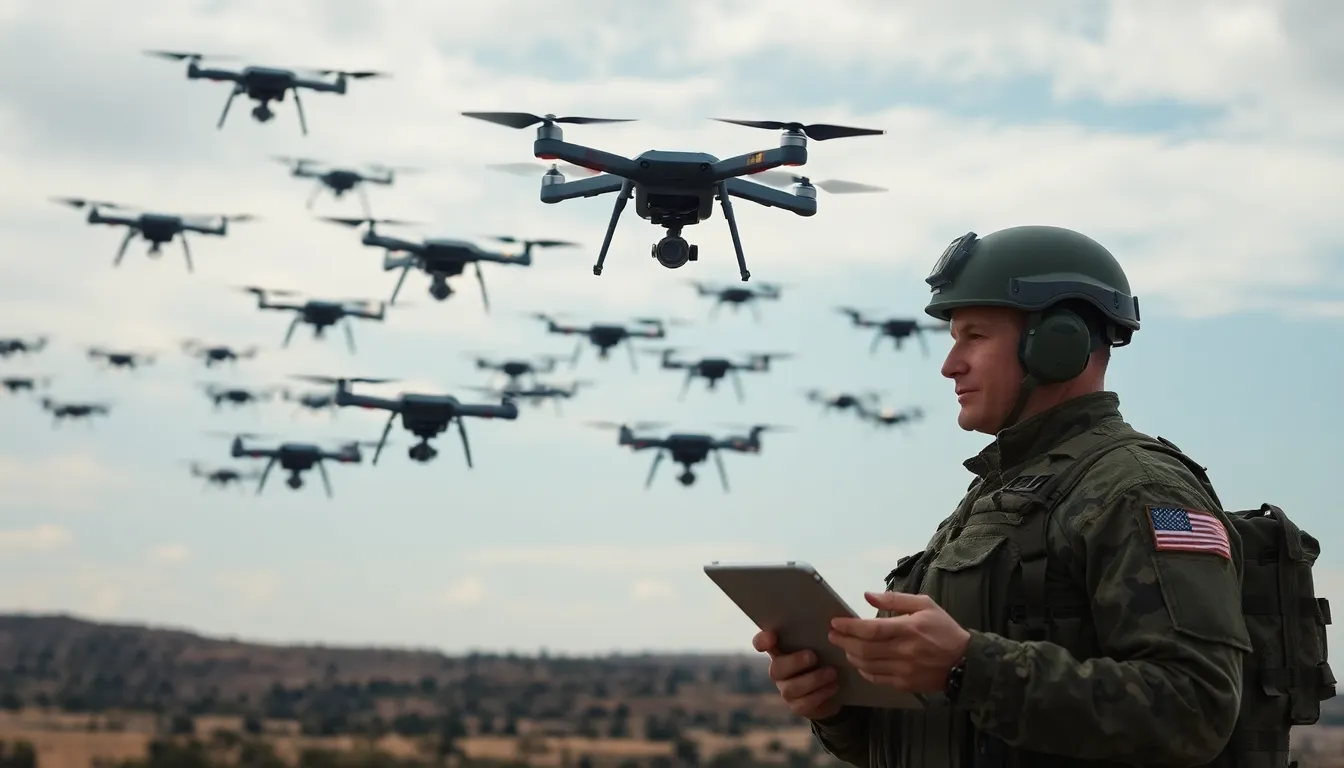Imagine a fleet of tiny flying robots zipping through the sky, working together like a well-rehearsed dance troupe. Swarm drones are the latest buzz in tech, and they’re not just for sci-fi movies anymore. These little aerial acrobats can communicate and coordinate to accomplish tasks more efficiently than any single drone could. Whether it’s delivering packages, monitoring wildlife, or even performing search and rescue missions, swarm drones are changing the game.
Table of Contents
ToggleOverview of Swarm Drones
Swarm drones represent a significant advancement in drone technology. These autonomous flying units collaborate to accomplish tasks more efficiently than individual drones.
Definition of Swarm Drones
Swarm drones consist of multiple small drones that work together as a unified group. This coordination allows them to execute complex operations, such as monitoring environments or delivering packages. These drones communicate with each other in real-time, sharing information and adjusting their actions based on collective needs. The result is a dynamic system that enhances effectiveness and minimizes human intervention.
Key Features and Technology
Key features of swarm drones include advanced communication systems, autonomous navigation, and real-time data processing. These technologies enable seamless collaboration among the drones, optimizing task execution. Each drone incorporates sensors for obstacle detection and environmental awareness, improving operational safety. Additionally, algorithms facilitate group behavior, making it easier for drones to adapt to changing conditions. This combination of technology enhances the swarm’s adaptability and overall performance in diverse scenarios.
Applications of Swarm Drones

Swarm drones are transforming various sectors through innovative applications. These small flying robots work together in ways traditional drones can’t match.
Military Uses
In military contexts, swarm drones enhance operational capabilities. Swarm technology allows for reconnaissance missions, deploying multiple drones simultaneously to gather intelligence. Coordinated strikes can involve groups of drones working together for precision and effectiveness. These systems can adapt quickly to battlefield changes, providing military forces with real-time data and situational awareness. The flexibility of swarm drones makes them valuable for monitoring enemy movements and performing search-and-destroy missions.
Commercial Applications
Commercial sectors benefit significantly from swarm drones. These systems streamline package delivery by coordinating efforts to optimize routes, reducing delivery times. Agriculture companies utilize swarm drones for crop monitoring and pest control, collecting aerial data to inform farming practices. Construction firms employ swarm technology for site inspections, providing comprehensive overviews of large areas without increasing manpower. Companies leveraging swarm drones can improve efficiency and cut operational costs effectively.
Research and Development
Research and development fields explore swarm drones for various innovative purposes. Scientists study their applications in environmental monitoring, tracking wildlife populations, and studying ecosystems. Universities develop algorithms that enhance swarm behavior, focusing on coordination and communication. Collaborative research projects include disaster response simulations, where swarm drones assess damage and locate survivors efficiently. By examining these applications, researchers unlock new possibilities for swarm technology across many domains.
Advantages of Swarm Drones
Swarm drones provide significant advantages in various applications due to their unique capabilities. Their ability to operate collaboratively enhances numerous operational efficiencies.
Increased Efficiency
Efficiency increases when swarm drones operate collectively. For example, they can cover larger areas in less time compared to single drones. Each drone processes real-time data, allowing the swarm to adapt dynamically to environmental changes. Their advanced algorithms optimize task distribution among the drones. A group can complete a complex package delivery much faster than a single unit could manage. Moreover, ongoing communication between drones ensures seamless coordination, reducing delays and errors. Together, these factors contribute to higher productivity rates across diverse sectors.
Cost-Effectiveness
The cost-effectiveness of swarm drones significantly impacts various industries. Using multiple drones in a swarm reduces the need for extensive labor since they perform tasks autonomously. Investing in swarm technology often yields lower operational costs when compared to traditional methods. Swarm drones minimize equipment wear and tear by distributing workloads evenly among the units. Furthermore, their high efficiency allows organizations to achieve more with fewer resources. Industries benefit from this technology, leading to overall savings and increased profitability.
Challenges and Limitations
Swarm drones face several challenges that may hinder their implementation across different sectors. These challenges stem primarily from technical and regulatory aspects.
Technical Challenges
Technical limitations significantly impact the performance of swarm drones. Data transmission issues can arise when drones communicate over long distances, leading to potential delays or loss of information. Coordinating multiple units requires sophisticated algorithms that must be finely tuned to maintain efficiency and safety. Battery life poses another technical hurdle; many drones cannot sustain extended operations without recharging. Environmental factors, such as weather conditions, can also interfere with navigation and communication systems. Malfunctions in one or more drones may disrupt the entire swarm’s operations, necessitating robust fallback systems to ensure reliability.
Regulatory Issues
Regulatory frameworks lag behind the rapid advancements in swarm drone technology. Many countries lack comprehensive guidelines for operating multiple drones simultaneously, creating ambiguity in lawful usage. Privacy concerns often arise when drones are deployed in populated areas, complicating adherence to existing laws. Airspace management becomes another critical issue due to the potential for mid-air collisions between drones and other aircraft. Manufacturers must navigate differing regulations across borders, resulting in higher costs and complexities. These obstacles can delay the widespread adoption of swarm drones in both commercial and military applications.
Future of Swarm Drones
Swarm drones are set to transform industries with continuous advancements in technology and application.
Innovations on the Horizon
Researchers are making significant strides in swarm drone capabilities. Improved artificial intelligence is enhancing collaborative decision-making processes, leading to more efficient operations. Enhanced communication systems support faster and more reliable data exchange among drones, optimizing their collective tasks. Additionally, miniaturization of drone components enables greater versatility and longer flight times. New battery technologies are on the verge of increasing operational ranges, minimizing downtime during missions. As these innovations emerge, industries will likely adopt swarm drones more extensively, reshaping the landscape of automation.
Potential Market Growth
The swarm drone market is projected to experience substantial expansion in the coming years. Industry analysts estimate a compound annual growth rate exceeding 20%, driven by increased adoption across various sectors. Military applications, encompassing reconnaissance and surveillance, are among the key growth drivers. Commercial markets, particularly logistics and agriculture, are also witnessing rising interest in swarm drone technologies. Investments in research and development by major companies underscore the anticipated demand for advanced drone solutions. As this sector evolves, organizations embracing swarm drone technology can position themselves strategically for enhanced operational efficiency and profitability.
Swarm drones are set to transform industries by enhancing efficiency and reducing costs through their collaborative capabilities. As technology advances and challenges are addressed, the potential applications for swarm drones will only expand. Their ability to adapt in real-time and operate autonomously positions them as a game-changer in fields ranging from agriculture to military operations. Organizations that leverage this innovative technology will likely gain a competitive edge, paving the way for a future where swarm drones play an integral role in various sectors. Embracing this technology now could lead to substantial benefits and opportunities down the line.


